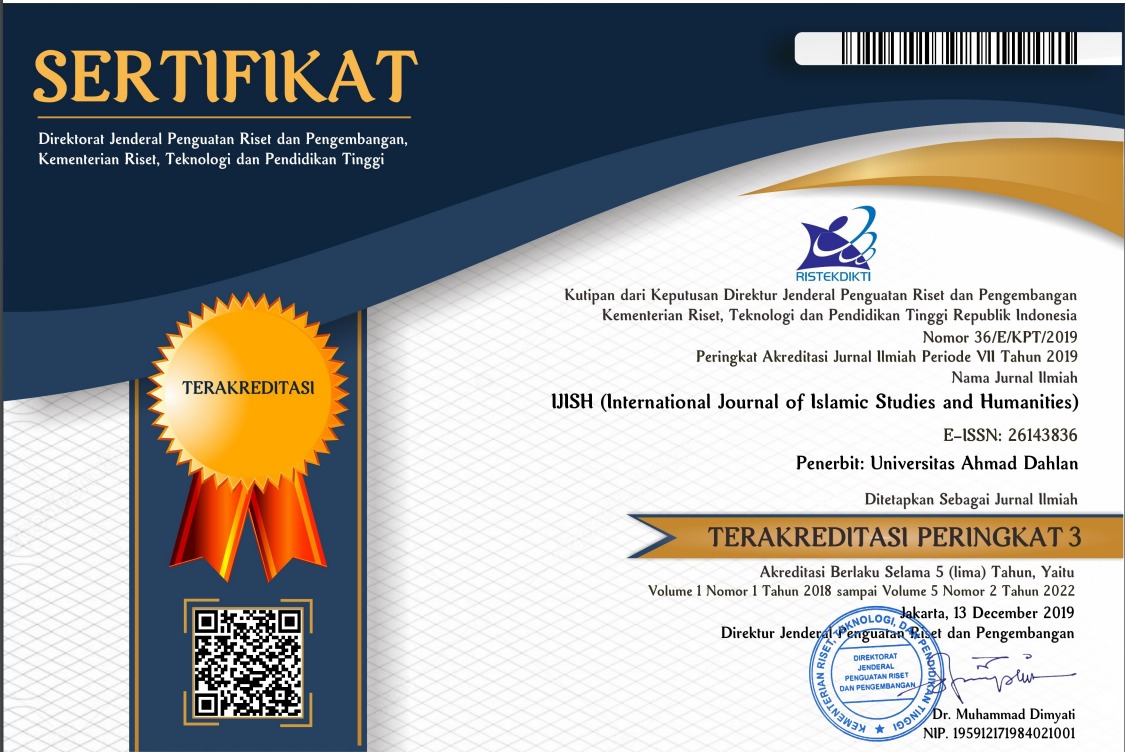How do Islamic movements in the 19th and 20th centuries in Egypt help define Islamic modernity?
DOI:
https://doi.org/10.26555/ijish.v7i1.8639Keywords:
Modernity, Islamic nation, Salafat movement, Al-Banna, Egypt, Globalization, Tajdid movement, Muslim BrotherhoodAbstract
This research article explores the concept of multiple “modernities” as a counter to Western modernity, with a specific focus on the modernization of Islam. The paper provides a historical context to the modernization of Islam by examining 18th, 19th, and 20th-century Islamic reforms and their impact on the religion while staying true to its core principles. It also examines the influence of globalization on Islamic nations, using Egypt as an example. The article challenges the Western-centric narrative of modernity by emphasizing that modernity is not confined to Europe and can emerge under different conditions in diverse regions. The study highlights the Tajdid movement, the Muslim Brotherhood, and the Salafat movement as examples of Islamic modernization efforts. The research demonstrates how these movements aimed to reform Islam while addressing global political, social, and economic changes. The article concludes that Islamic modernity is a dynamic and multifaceted phenomenon that combines traditional Islamic teachings with contemporary contexts.
References
Arnold, D. (2005). Europe, technology, and colonialism in the 20th century. History and Technology, 21(1), 85–106. https://doi.org/10.1080/07341510500037537
Chakrabarty, D. (2008). Provincializing Europe: Postcolonial Thought and Historical Difference. Princeton University Press. https://doi.org/10.1515/9781400828654
El-Sherif, A. (2015). Egypt’s Salafists at a Crossroads (Vol. 29). JSTOR.
Heffelfinger, C. (2007). Trends in Egyptian Salafi Activism. https://doi.org/10.21236/ADA475846
Hefner, R. W. (2010). The New Cambridge History of Islam: volume 6, Muslims and Modernity: Culture and Society since 1800. Cambridge University Press.
Jung, D., & Zalaf, A. el. (2019). Hasan Al-Banna and the Modern Muslim Self: Subjectivity Formation and the Search for an Islamic Order in Early 20th-Century Egypt. Numen, 66(4), 381–402. https://doi.org/10.1163/15685276-12341545
Kaviraj, S. (2005). An Outline of a Revisionist Theory of Modernity. European Journal of Sociology, 46(3), 497–526. https://doi.org/10.1017/S0003975605000196
Lapidus, I. (1997). Islamic Revival and Modernity: the Contemporary Movements and the Historical Paradigms. Journal of the Economic and Social History of the Orient, 40(4), 444–460. https://doi.org/10.1163/1568520972601486
Lepp, H. (2015). Sa’ad Zaghlul's Gramophone: The Effects of Popular Music on the Egyptian Nation. Intersect: The Stanford Journal of Science, Technology, and Society, 8(3).
Masud, M., Salvatore, A., & van Bruinessen, M. (2009). Islam and Modernity: Key Issues and Debates. Edinburgh University Press. https://doi.org/10.1515/9780748637942
van der Krogt, C. J. (2015). The Muslim Brotherhood in Contemporary Egypt: Democracy Redefined or Confined? Islam and Christian–Muslim Relations, 26(3), 382–384. https://doi.org/10.1080/09596410.2014.987556
Voll, J. O. (2011). Reform and modernism in the middle twentieth century. In The New Cambridge History of Islam Volume (Vol. 6).
Downloads
Published
How to Cite
Issue
Section
License
Copyright (c) 2024 Summaiya Kashif Kashif

This work is licensed under a Creative Commons Attribution-ShareAlike 4.0 International License.
Authors who publish with IJISH (International Journal of Islamic Studies and Humanities) agree to the following terms:
- Authors retain copyright and grant the journal right of first publication with the work simultaneously licensed under a Creative Commons Attribution License (CC BY-SA 4.0) that allows others to share the work with an acknowledgment of the work's authorship and initial publication in this journal.Â
- Authors are able to enter into separate, additional contractual arrangements for the non-exclusive distribution of the journal's published version of the work (e.g., post it to an institutional repository or publish it in a book), with an acknowledgment of its initial publication in this journal.
- Authors are permitted and encouraged to post their work online (e.g., in institutional repositories or on their website) prior to and during the submission process, as it can lead to productive exchanges, as well as earlier and greater citation of published work.

This work is licensed under a Creative Commons Attribution-ShareAlike 4.0 International License.






